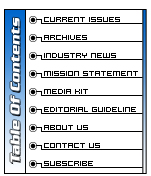|
From
the Publisher
By Roland Mangold
ESRI Conference Provides a Glimpse of the Future
Daniel J. Boorstin, author of The
Discoverers: A History of Man's Search to Know His World and
Himself wrote, "This is a story without end. All the world
is still an America. The most promising words ever written on
the maps of human knowledge are terra incognita-unknown
territory."
Unlike other trade shows and
conferences, the typical attire for attendees to the biggest
conference in the GeoTechnologies involves loose-fitting Hawaiian
shirts, Bermuda shorts, and hiking boots or Birkenstocks. In
a way, the ESRI International User Conference is mindful of
a giant Grateful Dead concert, with an entire industry growing
up around the near-charismatic draw of one group, one company.
It has certainly become the pinnacle event in the GIS industry,
with 11,000 attendees, 92 special-interest-group meetings, 129
technical workshops, and more than 360 paper presentations and
panel discussions within 43 categories that range from agriculture
to business, from banking and insurance to national defense,
from intelligence to mining, from the geosciences and petroleum
to telecommunications and water resources. The ESRI conference
serves up the most comprehensive view of everything that is
GIS today, and it furthermore gives us a glimpse of what GIS
might be in the future.
This year there were more than
180 exhibitors showing products and services including, but
not limited to, aerial photography, data servers, DEMs, DBMS,
field mapping, feature extraction, GPS, image processing, network
systems, photogrammetry, satellite imagery, 3D visualization,
and many more. Everything one could possibly imagine at a GIS
show was there, along with every conceivable application, process,
technique or philosophy, serving as an ocean in which thousands
of disciples could be immersed.
It may appear that I come here
simply to praise the empire that Jack Dangermond has built.
With success inevitably comes a long line of detractors as well
as sycophants. However, count me as a member of neither camp.
Among those critics of the ESRI phenomenon, numerous GIS products
and service providers will clandestinely denounce ESRI's business
practices. As dinner guests may criticize one's host while seated
at his table, these providers nonetheless see nothing wrong
with participating in, and taking advantage of opportunities
provided by these conferences.
An infamous cavil that portrays
ESRI users and employees as cult-like because of their zealous
devotion and dogmatic view of GIS, is a view enviously propagated
by their detractors. And there are certainly plenty of competitors-both
former and current-who claim that ESRI does not have the best
technology, and that there are plenty of better products on
the market.
But these remarks I personally
chalk up to "sour grapes," not unlike some of the complaints
directed at Bill Gates and Microsoft. We cannot fault the lion
for hunting down the gazelle. The nature of business is to defeat
one's competition, and it is inherently good business practice
to block opportunities for one's competitors. I am tired of
listening to the complaints of ex-CEOs who have lost out to
the likes of ESRI or Microsoft.
This phenomenon is a function
of what might be termed the "geekification" of North American
business. We are becoming a techno-geek society and, even with
the economic downturn, this sector continues to dominate the
economy. Nowhere in professional sports do we see losers suing
winners over unfair play. But in business-especially today where
business increasingly means technology-engineers, scientists,
technologists and computer specialists have become so enamored
of the technologies they developed-and the companies they built
around them-that they cannot fathom a situation where they are
not wildly successful. They whine when they fail, whether before
or after filing suit. Well, I say, "Get over it!"
In spite of his success, Jack
Dangermond does not come across as a bloodthirsty, bottom-line-driven
corporate executive. Instead, peering down through oversized
owlish glasses upon the thousands of faithful gathered to hear
his opening address at this users conference, Jack appeared
to be a benevolent, professorial uncle. He focused on the users
of his software and the great things they are doing, rather
than on the products themselves. He spoke of how GIS users from
around the world, and from countless disciplines, have become
a community-a community where the common denominator is GIS.
And with the proliferation of GIS and mapping on the Internet,
this industry has indeed gone "mainstream."
Consistently altruistic, Jack
expressed deep concern for the environment and imagined a future
where GIS could evolve into the Earth's central nervous system,
taking the pulse of the planet by means of GPS and other sensing
systems to ensure "better management of our Earth and its resources."
Not only is it exciting to witness
Jack's vision for the future of GIS, but also to hear from many
of the other leaders in the GeoTechnologies who hail from industry,
academia, and the public sector. Some have much in common with
Jack, while others are antithetical. I have not always personally
agreed with each of his positions. The sharing of GIS data is
one concept which I have a hard time embracing. The notion of
sharing something that has commercial value flies in the face
of a capitalistic, free enterprise system. However, it is hard
to argue with success. We cannot deny the contribution one man
and one organization has made to this industry.
Yet, there are countless individuals
out there who would vehemently disagree with many of the statements
I have made here, and they are banking on a scenario much different
from the one that Jack espouses. From the lofty heights of the
ESRI conference, we were treated to a glimpse of many possible
scenarios. One or more of these visions for GIS may very well
lie just over the horizon. But, more than likely, what truly
lies ahead is the unknown future of terra incognito.
Until next time, cheers!
Roland Mangold Publisher, EOM
E-mail: [email protected]
Back
|



